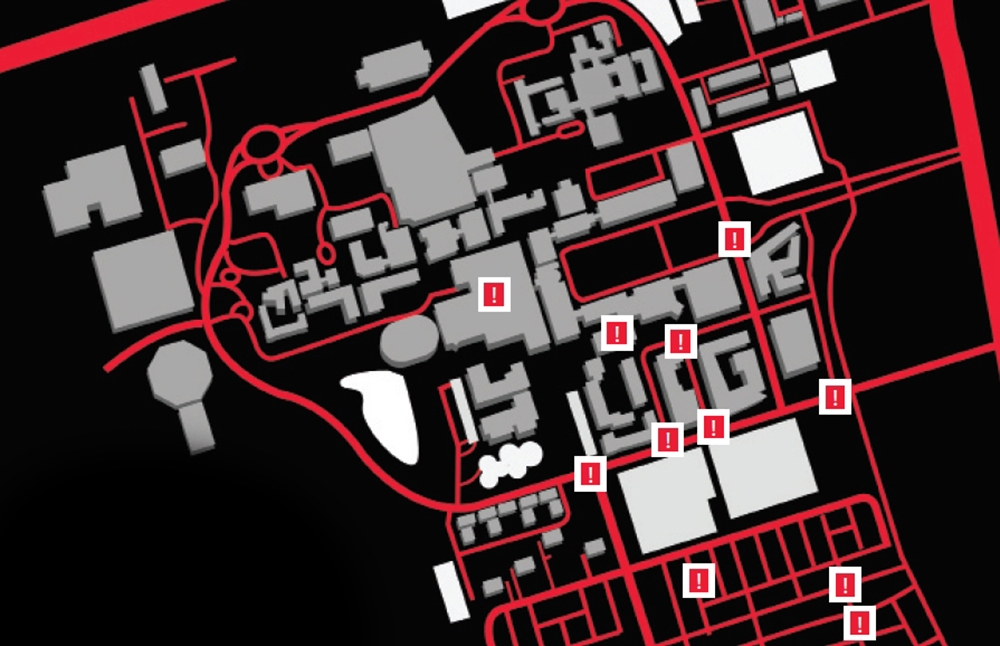Alex Kvaskov (News Editor) and Hassam Munir (Executive Editor – Online)
Featured illustration: Locations of the criminal activity reported through York security bulletins in 2016 (to date). | Christopher Lai (Creative Director)
York students may want to dress up as cops for Halloween this year after another violent crime in The Village. Or better yet, they can go as media critics. Indeed, many in our profession butter their bread with the oozy slime of regurgitated narratives inhabiting the ill-humoured public sphere. Here at Excalibur, crime is a regular entrant on our pitch lists. In fact, the journalistic vocation births a lurid psychopathy when reporters gleefully receive word of another unfortunate occurrence we can turn into a front page story.
But narratives are easy and facts are hard, so Excalibur has rounded up some figures and research to fact-check the pervasive narrative that the Keele campus is exceptionally unsafe.
In her 2008 master’s thesis, York alumna Haide Hall described her findings on media coverage of the Jane-Finch neighbourhood, particularly by the Toronto Star and The Globe and Mail. Echoing earlier studies, Hall showed that news about Jane-Finch tends to be negative and obscures any positive developments in the community, raising questions about the role of the press that is supposedly a bulwark between the public and its oppressors, afflicting the comfortable and comforting the afflicted.
Hall’s research sheds light on safety at York, arguing that “sustained repetition of the same news stories brands the community with a negative reputation and promotes a false stereotype of its residents.” The “branding” of a community in this way potentially sets off a domino effect in which recurring incidents are made to fit neatly into the brand instead of their underlying structural causes being addressed, according to Hall.
Crimes certainly occur at York, but other than their proximity to the main campus, frequently their connection to York is paltry and tenuous at best.
Nevertheless, Toronto’s major news outlets in reporting on the stabbing could be mistaken for a chorus belting out the same line. Each one included the dreaded words “York University” in their online headlines, not necessarily because it was the piece of information most relevant to the crime, but because perceptions of crime are now part of the York brand.
Statistics of crime in Toronto don’t add up to support this brand. In 2011, York University Heights ranked 41st out of 140 Toronto neighbourhoods for most occurrences of assault. In stark contrast, the Church-Yonge Corridor, where Ryerson University makes its home, is ranked fifth, while U of T’s neighbourhood, known simply as “University,” is ranked eighth. It should be noted that York University Heights is significantly larger in area than Church-Yonge and University combined. And yet, any incident occurring in York University Heights, as far removed from the university as it may be, is associated with York, but the same association is not made in the cases of Ryerson or U of T.
Recent coverage suggests the press has pulled a Jekyll-and-Hyde in comforting those deep inside their filter bubbles and further afflicting the already aggrieved. What’s worse, we can’t agree on a solution. Taken as a whole, the public has a severe case of multiple personality disorder: one former YFS presidential candidate promised to locate a police station on Keele campus, while other students have organized a group known as “Cops Off Campus” in the wake of Andrew Loku’s shooting. These diametrically opposed viewpoints coexist in the confines of a single campus and, like an untreated boil, have the tendency to break out every so often.
Lost in this obscure circle-jerk of self-reflection and indulgent agenda-setting are the true victims of the very real crimes. It was a crime of the flesh, for a man was stabbed; and it was a crime of the mind, for the victim was stabbed for a difference of opinion. Braying hyenas on the giant electric blue canary we know as Twitter, were soon tabulating conclusions in the coal mine where the aforementioned canary is choking.
The canary is a metaphor for our inflamed public sphere, amplifying the pronouncements of anyone with an opinion. The Star claiming the stabbing may have been religiously motivated was like a hit of heroin for reporters salivating for a scoop. All this raises ever-pertinent questions of journalistic integrity and objectivity. More fundamentally, what is the truth of the matter?
York continues to swim against the tide of an encumbering narrative. Despite a number of safety initiatives and a seeming commitment to transparency in the form of security bulletins, the labels of “crime,” “rape” and “robbery” remain super-glued to York’s reputation in the popular imagination. Yet, the war for hearts and minds comprises numerous fronts, and it’s surprising York isn’t more active on the media front. Then again, maybe they are. Maybe we’re just not listening.


